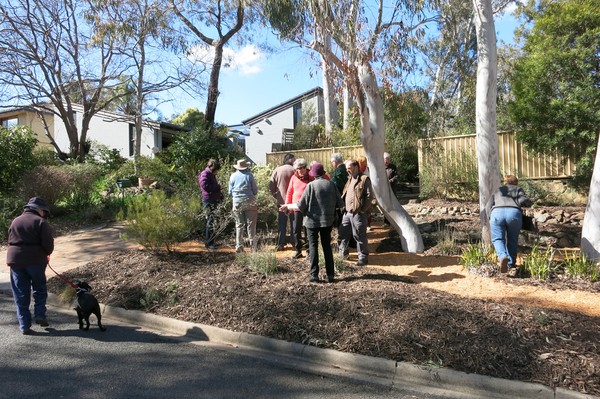Garden Design Study Group: Russell Garden
Aranda, ACT
We will be moving from our home and garden early next year. We have stopped planting and we have been rationalising our pots deciding what plants to take with us. I was asked recently how I felt about the house being sold and the fate of the garden being in the hands of new owners. As I feel I have no control over what eventually happens I have decided not to worry about it. We can only take our memories with us. While I know this there are times when the light falls a certain way perhaps in the morning or late afternoon and I have pangs of nostalgia for a way of life we have already begun to leave behind. I know that we will not be here this time next year. Looking back, we decided from the start that our garden would consist only of Australian natives and we remained true to that resolve. For fifteen years our garden has been our main hobby. We have spent days planning, landscaping, pruning, digging and planting. As the record keeper I have kept lists of the plants in each section of the garden and in a desultory fashion I have also kept lists of failed plants (so many). I did not use this list as a resource but they were interesting to look back on. This was because we came to realise that it was worth trying plants in different places in the garden and there are a number of reasons why plants fail. We also changed practices like including digging in more organic matter into what we had discovered was extremely poor soil.
During the fifteen years we have been here we have noticed more invasions of weeds and garden escapes in the area and we have had recently had African Daisy, Osteospermum ecklonis and Lavender Lavandula stoechas come into our garden. This is in addition to the usual suspects like Privet and Cotoneaster. We had difficulties with our neighbours’ potato vine and honeysuckle climbing over our wooden fence so we extended the fence upwards and it gave us a living green wall. It also gave us the benefit of extra privacy. We just have to watch out for stolons ranging into the garden.
I have included photos of of different views of the garden as well as as a photo of our courtyard which has been a source of great pleasure for us. It is a very private space with a view to west of the Brindabella Ranges. In the gardens that face the street our challenge has been to give enough structure so that when the small (and sometimes not so small) plants self-sow in the garden so it still looks like a horticultural endeavour and not a piece of bushland. We are acutely aware that the public generally wants ‘tidiness’ in the garden and we have developed the garden with the people who use the street in mind.
For more information on this garden see Garden Design Study Group Newsletter 92, November 2015, p. 13.




 Australian Native Plants Society (Australia)
Australian Native Plants Society (Australia)